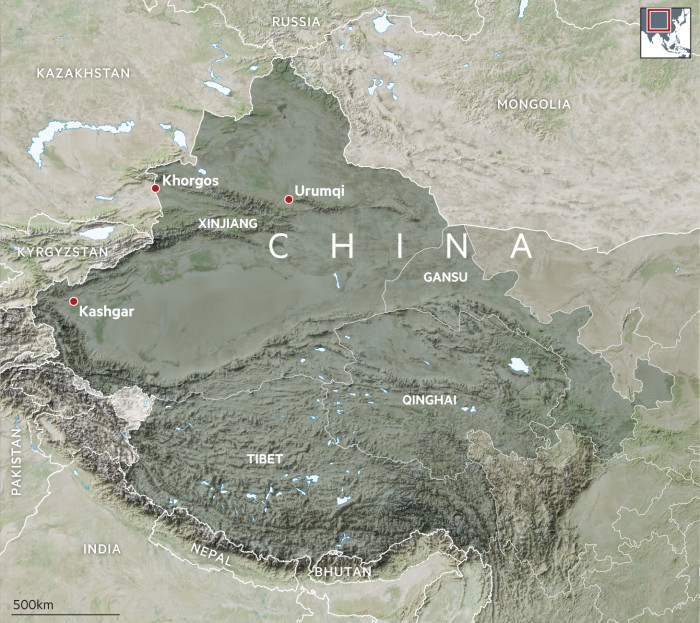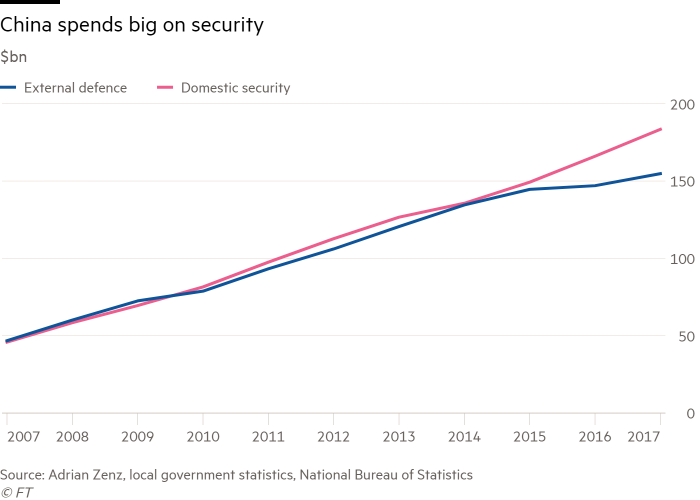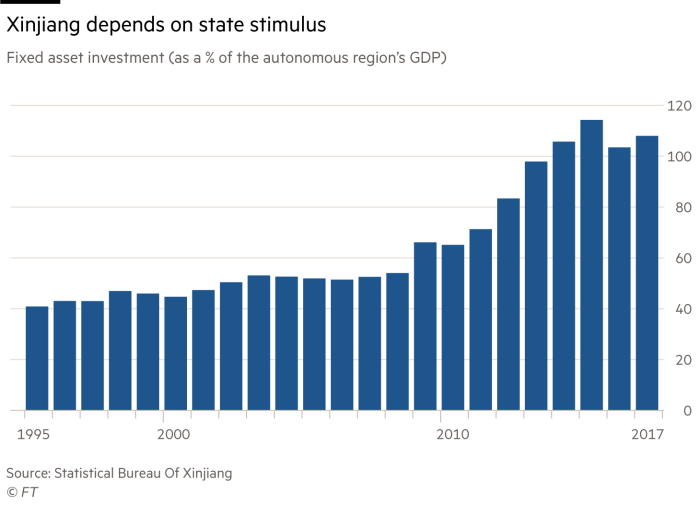Crackdown in Xinjiang: Where have all the people gone?
Simply sign up to the Chinese politics & policy myFT Digest -- delivered directly to your inbox.
The first thing you notice is the quiet. Then the white strips of paper stretched diagonally across the front doors of stores that look like they were vacated in a hurry. Once you get close enough, you can read the painted serial numbers on the house walls — WB-BUK 1 to 15 on one street — that tell you no one is coming back to these homes, and that many of those who lived there have been detained.
Welcome to Xinjiang in China’s north west. Twice the size of Germany, it holds crucial energy assets in its deserts: the country’s largest natural gas reserves, almost half of its coal, a fifth of its oil. It is a vital artery for President Xi Jinping’s Belt and Road Initiative (BRI) and markets in central Asia and the Middle East.
Yet it has also, over the past two years, become the scene of one of China’s most intense, largely hidden crackdowns. Hundreds of thousands of people have been placed in extralegal detention, in a move that has focused on the Uighurs, a Turkic Muslim group that makes up almost half the 23m population in the region.
In the eyes of the ruling Communist party, the geopolitical dreams it holds for Xinjiang are complicated by the Uighurs, who are far from the pliant workforce it needs to exploit the region’s resources. It is a deficit Beijing has so far remedied through the mass recruitment of Han workers, China’s dominant ethnic group. But a history of shortlived Uighur independence movements has put Beijing — ultra-sensitive about Taiwan and Tibet already — on edge.
“Xinjiang is a crucial element in the BRI because two of its economic corridors pass through [the region],” says Wang Dehua, a professor at Shanghai Institute for International Studies. “Without Xinjiang’s stability, nothing else can be achieved.”

Yet a scheme designed to bring more security to the region has severely restricted freedom of movement, with its Uighur population unable to move freely or leave the country, after those with passports had them seized in 2016. The crackdown has put BRI partner countries — seven of them border Xinjiang — on edge, creating concerns that the security clampdown might spill out across China’s borders.
Xinjiang is a far cry from the thriving Silk Road hub China envisioned. Rather than bustling, some neighbourhoods in the regional capital Urumqi and Kashgar, once the most culturally vibrant city, are deserted, stripped of people and life. Instead, China has been drawn deeper into an endless security build-up as Uighurs battle for survival.
To maintain its control over Xinjiang, China is building one of the most advanced police states — and spending billions to do so.
“The two — securitisation and Belt and Road — are inherently at odds,” says James Leibold, professor of Chinese history at La Trobe University in Melbourne. “In my opinion, security currently trumps economic development in Xinjiang.”
Xinjiang’s public security budget nearly doubled last year, to Rmb57.95bn ($9.16bn), according to local government statistics, eight times higher than the growth rate for China’s total public security budget. Security costs have increased 10-fold since 2009, when ethnic riots erupted across the region, leaving hundreds dead. Since then there have been periodic attacks blamed on Uighurs, including a 2014 knife assault at a train station in Kunming, in the southwestern province of Yunnan, that killed 33.
Much of Xinjiang’s security apparatus is state subsidised to sustain projects that otherwise defy economic logic. The state-led investment into security-related infrastructure and services has allowed the region to maintain an annual average 9.9 per cent growth in gross domestic product over the past decade.
The crackdown coincided with the arrival of Xinjiang’s new party secretary Chen Quanguo, fresh from a stint as the top party official charged with pacifying the similarly tense neighbouring region of Tibet. Under his short tenure, Xinjiang has built a system of intense digital and physical surveillance.

Hikvision, the world’s largest security camera manufacturer, has been a prime beneficiary. Last year, it won a contract worth Rmb368m in Xinjiang’s Yutian county, about 15 per cent of the GDP generated by the county, according to government documents. A second project in Moyu county is valued at Rmb300m, or 10 per cent of the county’s annual revenue.
Other funds are being diverted to surveillance software used to spy on citizens. An FT analysis of mobile software that Xinjiang residents were forced to download last year found that it scans for digital fingerprints matching illicit files, informing authorities when it finds them. Possessing sensitive digital content is a common reason for detention, so some Uighurs conspicuously abstain from smartphones despite living in one of the most mobile-oriented countries in the world.
According to reports and accounts from human rights groups cited by the US Congressional-Executive Commission on China, at least 500,000 Uighurs are in detention or have been recently held. In April, its two chairs, lawmakers Marco Rubio and Chris Smith, called Xinjiang “the largest mass incarceration of a minority population in the world today”. In southern Xinjiang, where policing is the most intense, up to 80 per cent of adults in urban neighbourhoods have been rounded up according to remaining residents.
“So many people, mostly the men, were imprisoned for so-called ‘913’ crimes: having forbidden digital content on their phones,” says Alfiya, a Kashgar housewife.
Chinese media have in part masked the sudden disappearance of such a large part of Xinjiang’s population by absorbing it into more innocuous initiatives. For instance, according to the People’s Daily, the official mouthpiece of the Chinese Communist party, a national poverty alleviation programme relocated 461,000 rural Xinjiang residents in the first three months of 2018. Calls to Xinjiang’s provincial government and public security arm went unanswered.
Those who have travelled internationally or have family members abroad, particularly in Muslim majority countries, are also targets. But as the crackdown has intensified even Uighurs who travel within China have been arrested. Adil, a businessman who asked not to reveal his family name and now lives in Turkey, says two of his brothers disappeared in 2016. Later, his family were told the pair had been brought back to Xinjiang and detained for travelling to the southern Chinese city of Guangzhou.
“We do not know the exact charges. We were told that they were questioned about why they had gone inland [out of Xinjiang] and sentenced in secret,” says Adil, who has been unable to contact his brothers since.
The escalation in detentions is ripping families apart. “The last time I talked to my son, he said, ‘Why do you not come back when I miss you so much?’’’ says Dilnur Ana, a Uighur living in Istanbul. She left to study in 2016, leaving a five-year-old son and a seven-year-old daughter in Kashgar. Harassed by local authorities, her family members cut off communication in April.

“You cannot know the pain that I feel as a mother at not being able to see my children. I have not heard their voices in more than a year,” she says, her voice cracking.
Empty streets in Urumqi and Kashgar are an eerie testament to how the security campaign is fraying Xinjiang’s economic and social fabric.
“The economic problems here are huge,” says a Han businessman surnamed Dong, who moved back to Urumqi from the northern province of Liaoning to be closer to his family. “There are not enough people to fill all the open jobs, and there is no one left to buy your goods. Imagine what happens when you remove that many people.”
For the hundreds of thousands of detainees there is no clear process for exiting the detention centres — many have been in extralegal limbo for more than a year. Public security officials must personally vouch for an individual detainee to secure their release, but such cases are rare.
“You can never ‘learn’ that stuff well enough to get out,” Kuerban, an Urumqi trader, says wryly, using a euphemistic term for the daily propaganda classes detainees take. His nephew was held in March after receiving a phone call from police in his hometown of Kashgar ordering him to return from Urumqi.
A huge security presence has smothered dissent but many quietly seethe at the daily indignities. “Why is it that I have to stop at checkpoints but Han Chinese do not? Why is it that I cannot have a passport but other people can?” says Yasinjiang, a Kashgar driver. “Why is it only Uighurs who must be subject to these security practices?”
The impact is beginning to be felt outside the region. Once thriving trade with China’s neighbours in central Asia and Pakistan has dried up, with foreign traders unable to receive their usual one-month visas due to heightened security screening. Inventory depots, where traders gather to make deals, offload goods and exchange currency, have seen traffic plummet. During a June afternoon, one such Urumqi depot frequented by central Asian traders sat largely empty, its storefronts locked up.
Among those caught in the middle are China’s ethnic Kazakhs, who for decades crossed the border between China and Kazakhstan freely. The security clampdown has made that much more difficult — a fact exposed at the trial of a Chinese-Kazakh woman, forced to work at a Xinjiang internment centre before fleeing to Kazakhstan.
Chinese authorities pushed to extradite Sayragul Sauytbay but her family insisted the request was politically motivated because she possessed sensitive information about the detention centres. Last Wednesday a Kazakh court turned down the extradition request.
What that legal decision means for relations between Kazakhstan and its powerful neighbour and trading partner remains unclear. The foreign ministry in Astana says Kazakh diplomats have repeatedly raised the issue of its citizens being detained in Xinjiang. A visit by a deputy foreign minister in April to Urumqi secured the release of Kazakh citizens but diplomats have avoided speaking out for fear of a backlash.
“Kazakhstan is relatively small and dependent on China [so it] has to play the game,” says one prominent Kazakh lawyer who has worked on Chinese infrastructure projects in the country. “We don’t diss the Chinese dragon or the Russian bear, or we could end up like Crimea and Georgia.” Internationally, diplomatic efforts have come to a standstill because Chinese officials categorically deny anything is wrong in Xinjiang, describing internment centres as “vocational training”, say western diplomats.
This June, during a meeting between US academics and Chinese military officials, the Beijing delegation appeared confused when the US group raised Xinjiang’s mass detentions and religious restrictions. According to one person present, “the Chinese side basically said: ‘If there was a problem in Xinjiang, we would know about it.’”
Model villages: China engineers ethnic unity in bid to ease tensions
Carved out of the Taklamakan desert and down a road only paved last year is an unlikely sight: Xinjiang’s first “Ethnic Unity Village”, a walled settlement protected by armed guards.
Half of its 1,000 or so residents are Uighur and half are Han, lured with free housing and subsidies. The houses, covered with cheery murals depicting scenes of ethnic co-operation, are assigned so that the two groups live side by side. Built in 2014, the village is the idea of local officials to showcase innovative agricultural and social policies. Most of the village is covered by greenhouses, in which residents are supposed to grow vegetables in the frigid winters and arid summers. Nearby, the desert has been flattened for date and walnut fields, irrigated by underground aquifers.
The scheme can accommodate 5,000 families, but the village is largely empty, the greenhouses unused. Its residents say they have been unable to create the agricultural success envisaged by village planners. “We came to make money, but neither of us knows how to grow crops,” says a Uighur woman who moved to the village two years ago with her husband.
Meanwhile, few of the village residents speak both Mandarin and Uighur, so neighbours live in amiable isolation from one another.
“The Uighurs are a very polite people. They always offer me a ride if they see me walking, but I cannot understand anything they say,” says Meng Jingwen, a migrant from Henan province. She ekes out a living by running a convenience store.
However, officials have declared the village a success, and farther out in the desert, the finishing touches are now being put on two more ethnic unity villages, Jinye and Yuye, built with financial sponsorship from China’s state tobacco enterprise.
Letter in response to this article:
Harmony in Xinjiang is based on three principles / From Liu Xiaoming, Ambassador of China to the UK
Comments